Cert IV Finance: Financial Services Legislation & Compliance
VerifiedAdded on 2023/06/18
|27
|10018
|215
Homework Assignment
AI Summary
This assignment focuses on financial services legislation and compliance within the Australian context, particularly in relation to the finance broking industry. It includes tasks such as analyzing the impact of external economic forces on interest rates, understanding the roles of different financial sectors in influencing these rates, and updating organizational policies and credit guides to reflect changes brought about by the Australian Financial Complaints Authority (AFCA). The assignment requires writing a staff memo detailing the benefits and key considerations of AFCA membership, and ensuring that consumer-facing materials accurately reflect AFCA's role in dispute resolution. The tasks involve referencing industry articles, the AAMC Training learner guide, the FMB Assessment Toolkit, and the AFCA website to provide well-informed and compliant responses.
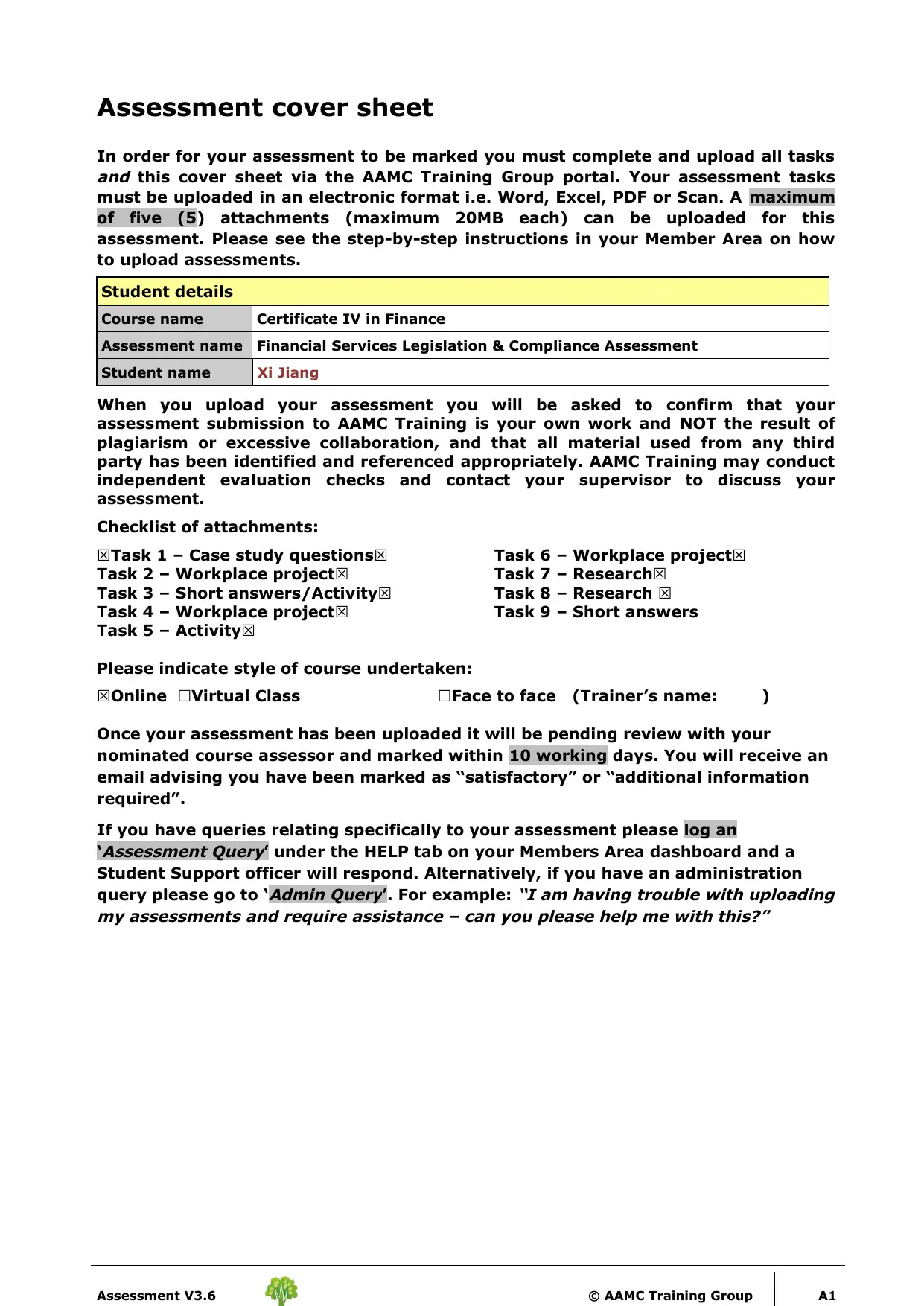
Assessment cover sheet
In order for your assessment to be marked you must complete and upload all tasksand this cover sheet via the AAMC Training Group portal. Your assessment tasks
must be uploaded in an electronic format i.e. Word, Excel, PDF or Scan. A maximum
of five (5) attachments (maximum 20MB each) can be uploaded for this
assessment. Please see the step-by-step instructions in your Member Area on how
to upload assessments.
Student details
Course name Certificate IV in Finance
Assessment name Financial Services Legislation & Compliance Assessment
Student name Xi Jiang
When you upload your assessment you will be asked to confirm that your
assessment submission to AAMC Training is your own work and NOT the result of
plagiarism or excessive collaboration, and that all material used from any third
party has been identified and referenced appropriately. AAMC Training may conduct
independent evaluation checks and contact your supervisor to discuss your
assessment.
Checklist of attachments:
☒Task 1 – Case study questions☒
Task 2 – Workplace project☒
Task 3 – Short answers/Activity☒
Task 4 – Workplace project☒
Task 5 – Activity☒
Task 6 – Workplace project☒
Task 7 – Research☒
Task 8 – Research ☒
Task 9 – Short answers
Please indicate style of course undertaken:
☒Online ☐Virtual Class ☐Face to face (Trainer’s name: )
Once your assessment has been uploaded it will be pending review with your
nominated course assessor and marked within 10 working days. You will receive an
email advising you have been marked as “satisfactory” or “additional information
required”.
If you have queries relating specifically to your assessment please log an
‘
Assessment Query’ under the HELP tab on your Members Area dashboard and a
Student Support officer will respond. Alternatively, if you have an administration
query please go to ‘
Admin Query’. For example:
“I am having trouble with uploading
my assessments and require assistance – can you please help me with this?”
Assessment V3.6 © AAMC Training Group A1
In order for your assessment to be marked you must complete and upload all tasksand this cover sheet via the AAMC Training Group portal. Your assessment tasks
must be uploaded in an electronic format i.e. Word, Excel, PDF or Scan. A maximum
of five (5) attachments (maximum 20MB each) can be uploaded for this
assessment. Please see the step-by-step instructions in your Member Area on how
to upload assessments.
Student details
Course name Certificate IV in Finance
Assessment name Financial Services Legislation & Compliance Assessment
Student name Xi Jiang
When you upload your assessment you will be asked to confirm that your
assessment submission to AAMC Training is your own work and NOT the result of
plagiarism or excessive collaboration, and that all material used from any third
party has been identified and referenced appropriately. AAMC Training may conduct
independent evaluation checks and contact your supervisor to discuss your
assessment.
Checklist of attachments:
☒Task 1 – Case study questions☒
Task 2 – Workplace project☒
Task 3 – Short answers/Activity☒
Task 4 – Workplace project☒
Task 5 – Activity☒
Task 6 – Workplace project☒
Task 7 – Research☒
Task 8 – Research ☒
Task 9 – Short answers
Please indicate style of course undertaken:
☒Online ☐Virtual Class ☐Face to face (Trainer’s name: )
Once your assessment has been uploaded it will be pending review with your
nominated course assessor and marked within 10 working days. You will receive an
email advising you have been marked as “satisfactory” or “additional information
required”.
If you have queries relating specifically to your assessment please log an
‘
Assessment Query’ under the HELP tab on your Members Area dashboard and a
Student Support officer will respond. Alternatively, if you have an administration
query please go to ‘
Admin Query’. For example:
“I am having trouble with uploading
my assessments and require assistance – can you please help me with this?”
Assessment V3.6 © AAMC Training Group A1
Paraphrase This Document
Need a fresh take? Get an instant paraphrase of this document with our AI Paraphraser
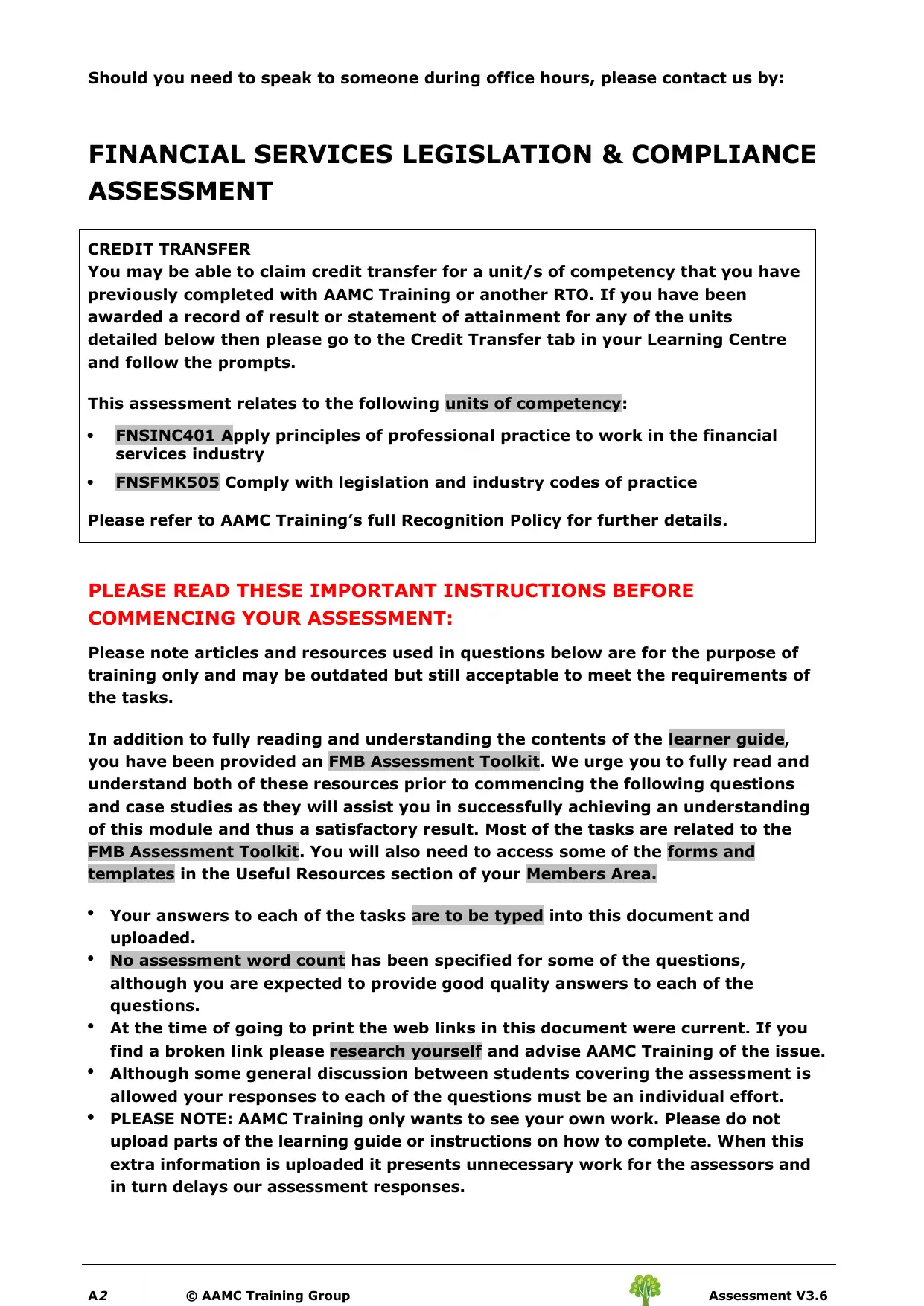
Should you need to speak to someone during office hours, please contact us by:
FINANCIAL SERVICES LEGISLATION & COMPLIANCE
ASSESSMENT
CREDIT TRANSFER
You may be able to claim credit transfer for a unit/s of competency that you have
previously completed with AAMC Training or another RTO. If you have been
awarded a record of result or statement of attainment for any of the units
detailed below then please go to the Credit Transfer tab in your Learning Centre
and follow the prompts.
This assessment relates to the following units of competency:
FNSINC401 Apply principles of professional practice to work in the financial
services industry
FNSFMK505 Comply with legislation and industry codes of practice
Please refer to AAMC Training’s full Recognition Policy for further details.
PLEASE READ THESE IMPORTANT INSTRUCTIONS BEFORE
COMMENCING YOUR ASSESSMENT:
Please note articles and resources used in questions below are for the purpose of
training only and may be outdated but still acceptable to meet the requirements of
the tasks.
In addition to fully reading and understanding the contents of the learner guide,
you have been provided an FMB Assessment Toolkit. We urge you to fully read and
understand both of these resources prior to commencing the following questions
and case studies as they will assist you in successfully achieving an understanding
of this module and thus a satisfactory result. Most of the tasks are related to the
FMB Assessment Toolkit. You will also need to access some of the forms and
templates in the Useful Resources section of your Members Area.
Your answers to each of the tasks are to be typed into this document and
uploaded.
No assessment word count has been specified for some of the questions,
although you are expected to provide good quality answers to each of the
questions.
At the time of going to print the web links in this document were current. If you
find a broken link please research yourself and advise AAMC Training of the issue.
Although some general discussion between students covering the assessment is
allowed your responses to each of the questions must be an individual effort.
PLEASE NOTE: AAMC Training only wants to see your own work. Please do not
upload parts of the learning guide or instructions on how to complete. When this
extra information is uploaded it presents unnecessary work for the assessors and
in turn delays our assessment responses.
A
2 © AAMC Training Group Assessment V3.6
FINANCIAL SERVICES LEGISLATION & COMPLIANCE
ASSESSMENT
CREDIT TRANSFER
You may be able to claim credit transfer for a unit/s of competency that you have
previously completed with AAMC Training or another RTO. If you have been
awarded a record of result or statement of attainment for any of the units
detailed below then please go to the Credit Transfer tab in your Learning Centre
and follow the prompts.
This assessment relates to the following units of competency:
FNSINC401 Apply principles of professional practice to work in the financial
services industry
FNSFMK505 Comply with legislation and industry codes of practice
Please refer to AAMC Training’s full Recognition Policy for further details.
PLEASE READ THESE IMPORTANT INSTRUCTIONS BEFORE
COMMENCING YOUR ASSESSMENT:
Please note articles and resources used in questions below are for the purpose of
training only and may be outdated but still acceptable to meet the requirements of
the tasks.
In addition to fully reading and understanding the contents of the learner guide,
you have been provided an FMB Assessment Toolkit. We urge you to fully read and
understand both of these resources prior to commencing the following questions
and case studies as they will assist you in successfully achieving an understanding
of this module and thus a satisfactory result. Most of the tasks are related to the
FMB Assessment Toolkit. You will also need to access some of the forms and
templates in the Useful Resources section of your Members Area.
Your answers to each of the tasks are to be typed into this document and
uploaded.
No assessment word count has been specified for some of the questions,
although you are expected to provide good quality answers to each of the
questions.
At the time of going to print the web links in this document were current. If you
find a broken link please research yourself and advise AAMC Training of the issue.
Although some general discussion between students covering the assessment is
allowed your responses to each of the questions must be an individual effort.
PLEASE NOTE: AAMC Training only wants to see your own work. Please do not
upload parts of the learning guide or instructions on how to complete. When this
extra information is uploaded it presents unnecessary work for the assessors and
in turn delays our assessment responses.
A
2 © AAMC Training Group Assessment V3.6

Assessment V3.6 © AAMC Training Group A3
⊘ This is a preview!⊘
Do you want full access?
Subscribe today to unlock all pages.

Trusted by 1+ million students worldwide
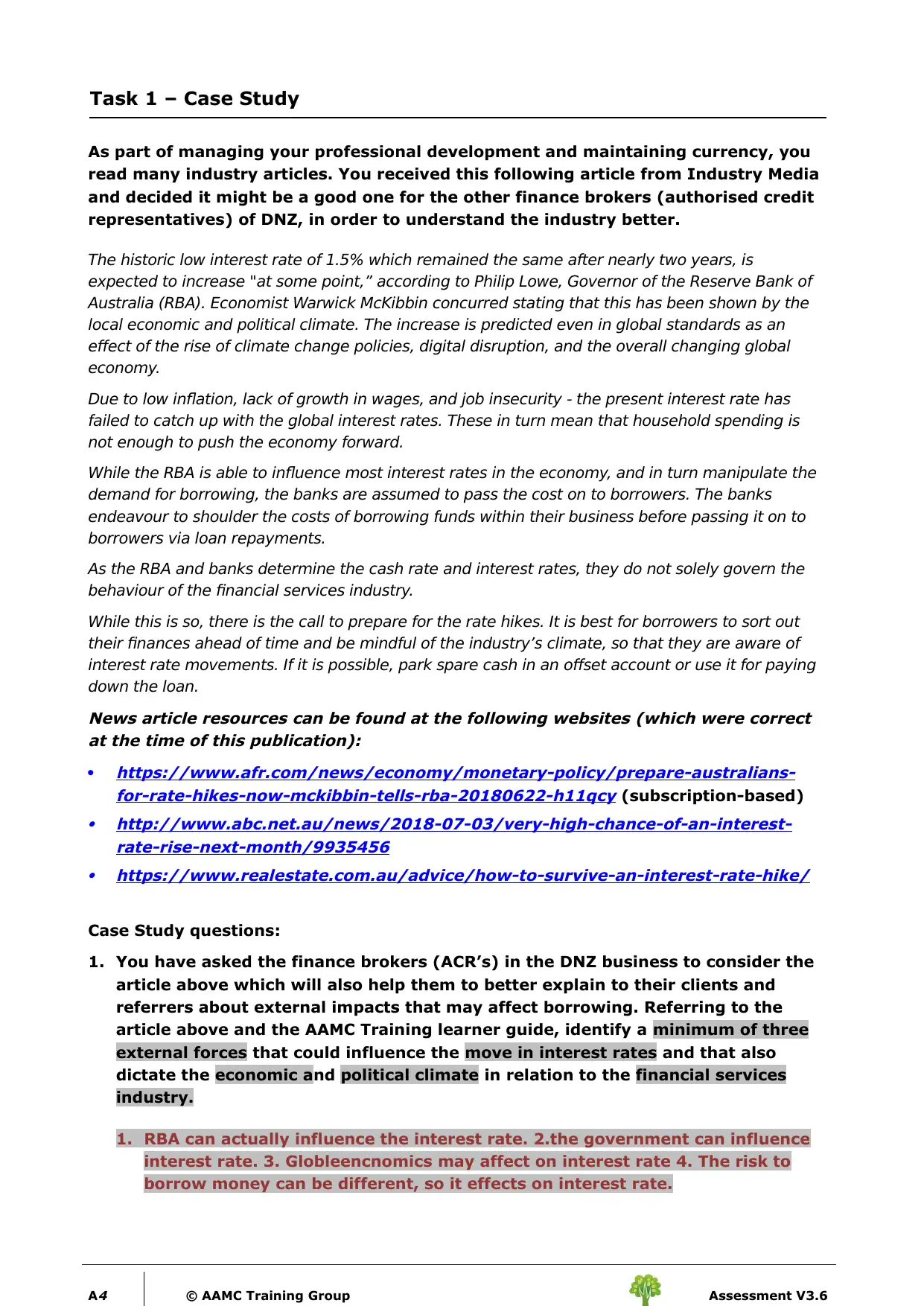
Task 1 – Case Study
As part of managing your professional development and maintaining currency, you
read many industry articles. You received this following article from Industry Media
and decided it might be a good one for the other finance brokers (authorised credit
representatives) of DNZ, in order to understand the industry better.
The historic low interest rate of 1.5% which remained the same after nearly two years, is
expected to increase "at some point,” according to Philip Lowe, Governor of the Reserve Bank of
Australia (RBA). Economist Warwick McKibbin concurred stating that this has been shown by the
local economic and political climate. The increase is predicted even in global standards as an
effect of the rise of climate change policies, digital disruption, and the overall changing global
economy.
Due to low inflation, lack of growth in wages, and job insecurity - the present interest rate has
failed to catch up with the global interest rates. These in turn mean that household spending is
not enough to push the economy forward.
While the RBA is able to influence most interest rates in the economy, and in turn manipulate the
demand for borrowing, the banks are assumed to pass the cost on to borrowers. The banks
endeavour to shoulder the costs of borrowing funds within their business before passing it on to
borrowers via loan repayments.
As the RBA and banks determine the cash rate and interest rates, they do not solely govern the
behaviour of the financial services industry.
While this is so, there is the call to prepare for the rate hikes. It is best for borrowers to sort out
their finances ahead of time and be mindful of the industry’s climate, so that they are aware of
interest rate movements. If it is possible, park spare cash in an offset account or use it for paying
down the loan.
News article resources can be found at the following websites (which were correct
at the time of this publication):
https://www.afr.com/news/economy/monetary-policy/prepare-australians-
for-rate-hikes-now-mckibbin-tells-rba-20180622-h11qcy (subscription-based) http://www.abc.net.au/news/2018-07-03/very-high-chance-of-an-interest-
rate-rise-next-month/9935456
https://www.realestate.com.au/advice/how-to-survive-an-interest-rate-hike/
Case Study questions:
1. You have asked the finance brokers (ACR’s) in the DNZ business to consider the
article above which will also help them to better explain to their clients and
referrers about external impacts that may affect borrowing. Referring to the
article above and the AAMC Training learner guide, identify a minimum of three
external forces that could influence the move in interest rates and that also
dictate the economic and political climate in relation to the financial services
industry.
1. RBA can actually influence the interest rate. 2.the government can influence
interest rate. 3. Globleencnomics may affect on interest rate 4. The risk to
borrow money can be different, so it effects on interest rate.
A
4 © AAMC Training Group Assessment V3.6
As part of managing your professional development and maintaining currency, you
read many industry articles. You received this following article from Industry Media
and decided it might be a good one for the other finance brokers (authorised credit
representatives) of DNZ, in order to understand the industry better.
The historic low interest rate of 1.5% which remained the same after nearly two years, is
expected to increase "at some point,” according to Philip Lowe, Governor of the Reserve Bank of
Australia (RBA). Economist Warwick McKibbin concurred stating that this has been shown by the
local economic and political climate. The increase is predicted even in global standards as an
effect of the rise of climate change policies, digital disruption, and the overall changing global
economy.
Due to low inflation, lack of growth in wages, and job insecurity - the present interest rate has
failed to catch up with the global interest rates. These in turn mean that household spending is
not enough to push the economy forward.
While the RBA is able to influence most interest rates in the economy, and in turn manipulate the
demand for borrowing, the banks are assumed to pass the cost on to borrowers. The banks
endeavour to shoulder the costs of borrowing funds within their business before passing it on to
borrowers via loan repayments.
As the RBA and banks determine the cash rate and interest rates, they do not solely govern the
behaviour of the financial services industry.
While this is so, there is the call to prepare for the rate hikes. It is best for borrowers to sort out
their finances ahead of time and be mindful of the industry’s climate, so that they are aware of
interest rate movements. If it is possible, park spare cash in an offset account or use it for paying
down the loan.
News article resources can be found at the following websites (which were correct
at the time of this publication):
https://www.afr.com/news/economy/monetary-policy/prepare-australians-
for-rate-hikes-now-mckibbin-tells-rba-20180622-h11qcy (subscription-based) http://www.abc.net.au/news/2018-07-03/very-high-chance-of-an-interest-
rate-rise-next-month/9935456
https://www.realestate.com.au/advice/how-to-survive-an-interest-rate-hike/
Case Study questions:
1. You have asked the finance brokers (ACR’s) in the DNZ business to consider the
article above which will also help them to better explain to their clients and
referrers about external impacts that may affect borrowing. Referring to the
article above and the AAMC Training learner guide, identify a minimum of three
external forces that could influence the move in interest rates and that also
dictate the economic and political climate in relation to the financial services
industry.
1. RBA can actually influence the interest rate. 2.the government can influence
interest rate. 3. Globleencnomics may affect on interest rate 4. The risk to
borrow money can be different, so it effects on interest rate.
A
4 © AAMC Training Group Assessment V3.6
Paraphrase This Document
Need a fresh take? Get an instant paraphrase of this document with our AI Paraphraser
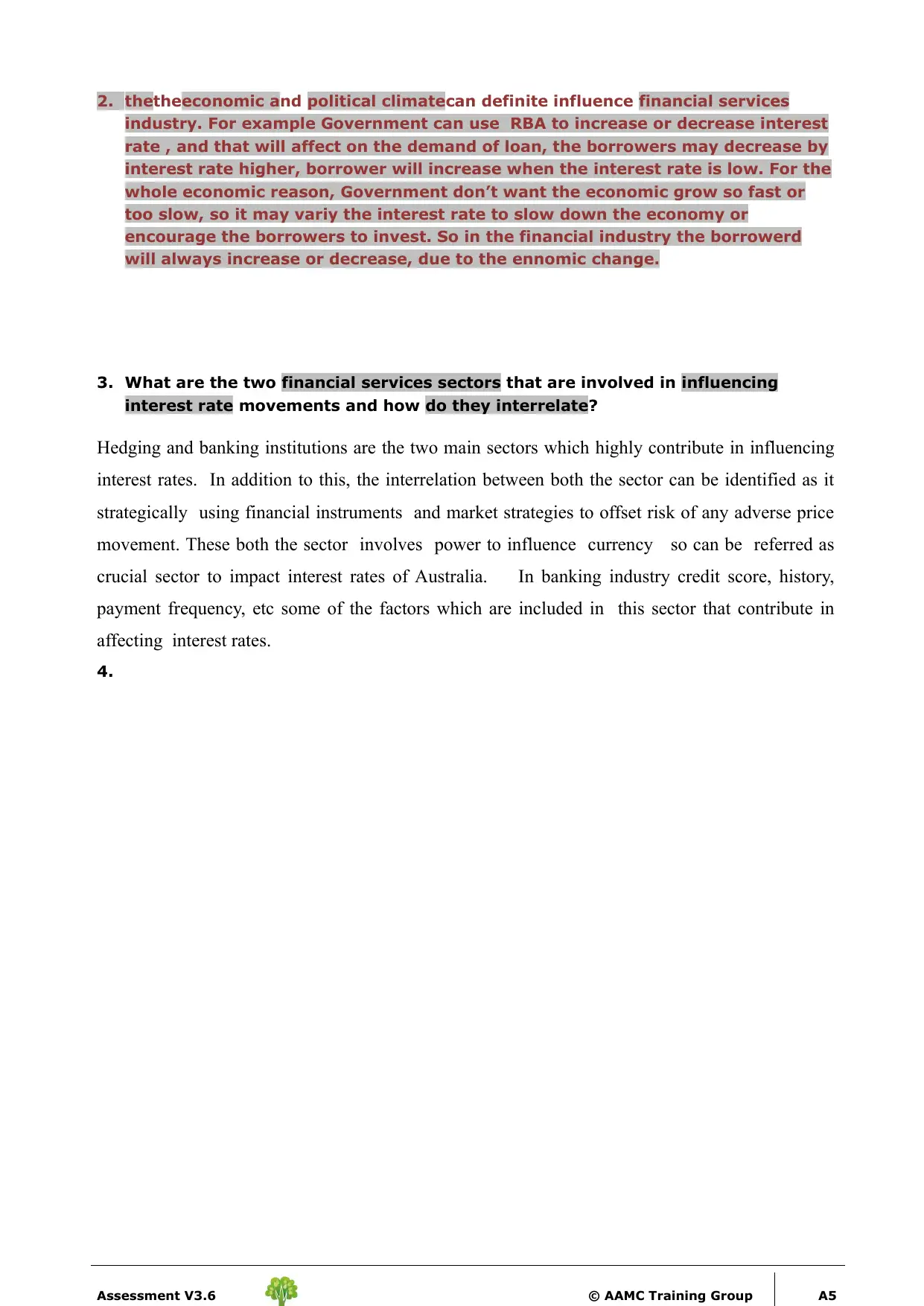
2. thetheeconomic and political climatecan definite influence financial services
industry. For example Government can use RBA to increase or decrease interest
rate , and that will affect on the demand of loan, the borrowers may decrease by
interest rate higher, borrower will increase when the interest rate is low. For the
whole economic reason, Government don’t want the economic grow so fast or
too slow, so it may variy the interest rate to slow down the economy or
encourage the borrowers to invest. So in the financial industry the borrowerd
will always increase or decrease, due to the ennomic change.
3. What are the two financial services sectors that are involved in influencing
interest rate movements and how do they interrelate?
Hedging and banking institutions are the two main sectors which highly contribute in influencing
interest rates. In addition to this, the interrelation between both the sector can be identified as it
strategically using financial instruments and market strategies to offset risk of any adverse price
movement. These both the sector involves power to influence currency so can be referred as
crucial sector to impact interest rates of Australia. In banking industry credit score, history,
payment frequency, etc some of the factors which are included in this sector that contribute in
affecting interest rates.
4.
Assessment V3.6 © AAMC Training Group A5
industry. For example Government can use RBA to increase or decrease interest
rate , and that will affect on the demand of loan, the borrowers may decrease by
interest rate higher, borrower will increase when the interest rate is low. For the
whole economic reason, Government don’t want the economic grow so fast or
too slow, so it may variy the interest rate to slow down the economy or
encourage the borrowers to invest. So in the financial industry the borrowerd
will always increase or decrease, due to the ennomic change.
3. What are the two financial services sectors that are involved in influencing
interest rate movements and how do they interrelate?
Hedging and banking institutions are the two main sectors which highly contribute in influencing
interest rates. In addition to this, the interrelation between both the sector can be identified as it
strategically using financial instruments and market strategies to offset risk of any adverse price
movement. These both the sector involves power to influence currency so can be referred as
crucial sector to impact interest rates of Australia. In banking industry credit score, history,
payment frequency, etc some of the factors which are included in this sector that contribute in
affecting interest rates.
4.
Assessment V3.6 © AAMC Training Group A5
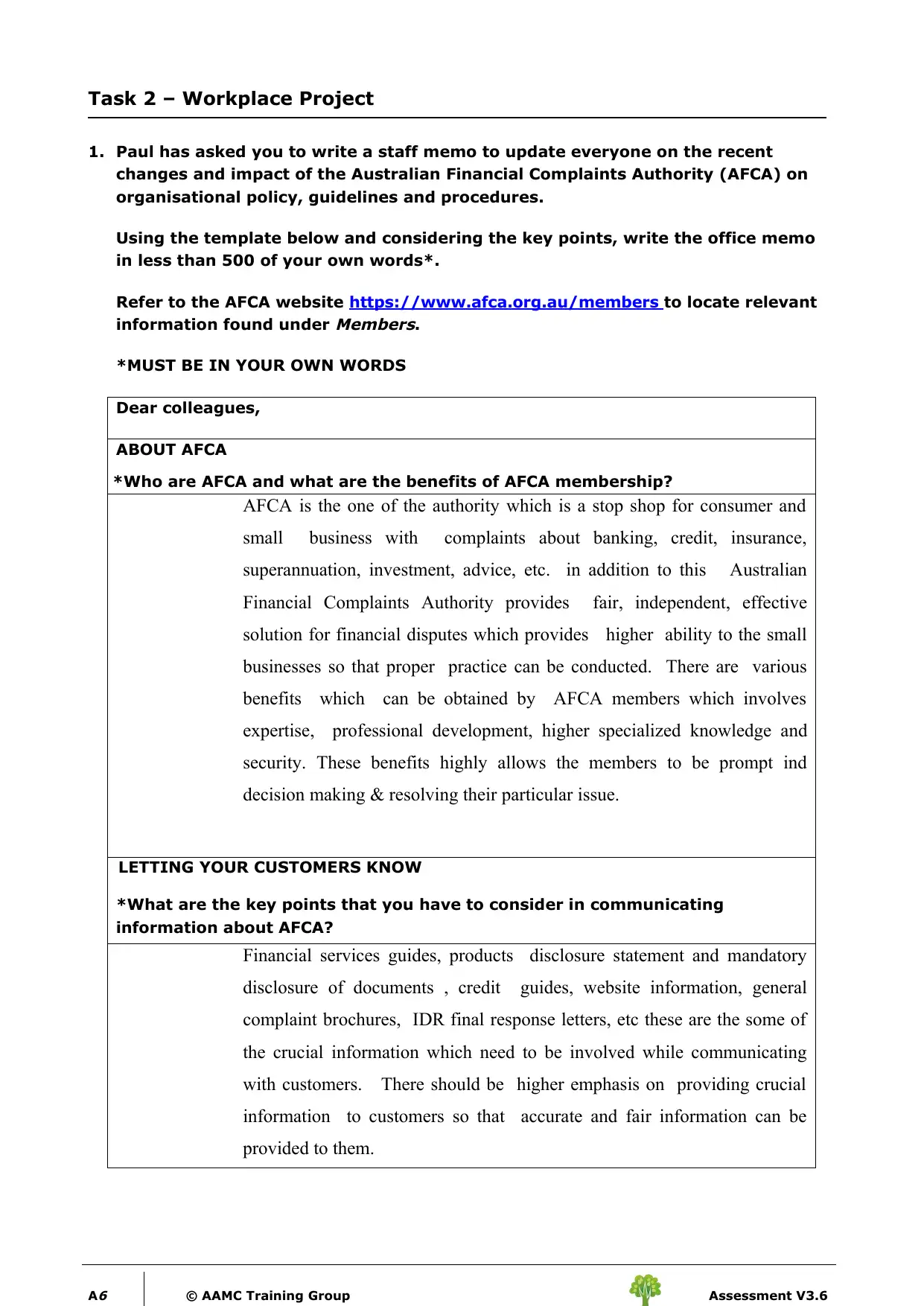
Task 2 – Workplace Project
1. Paul has asked you to write a staff memo to update everyone on the recent
changes and impact of the Australian Financial Complaints Authority (AFCA) on
organisational policy, guidelines and procedures.
Using the template below and considering the key points, write the office memo
in less than 500 of your own words*.
Refer to the AFCA website https://www.afca.org.au/members to locate relevant
information found under
Members.
*MUST BE IN YOUR OWN WORDS
Dear colleagues,
ABOUT AFCA
*Who are AFCA and what are the benefits of AFCA membership?
AFCA is the one of the authority which is a stop shop for consumer and
small business with complaints about banking, credit, insurance,
superannuation, investment, advice, etc. in addition to this Australian
Financial Complaints Authority provides fair, independent, effective
solution for financial disputes which provides higher ability to the small
businesses so that proper practice can be conducted. There are various
benefits which can be obtained by AFCA members which involves
expertise, professional development, higher specialized knowledge and
security. These benefits highly allows the members to be prompt ind
decision making & resolving their particular issue.
LETTING YOUR CUSTOMERS KNOW
*What are the key points that you have to consider in communicating
information about AFCA?
Financial services guides, products disclosure statement and mandatory
disclosure of documents , credit guides, website information, general
complaint brochures, IDR final response letters, etc these are the some of
the crucial information which need to be involved while communicating
with customers. There should be higher emphasis on providing crucial
information to customers so that accurate and fair information can be
provided to them.
A
6 © AAMC Training Group Assessment V3.6
1. Paul has asked you to write a staff memo to update everyone on the recent
changes and impact of the Australian Financial Complaints Authority (AFCA) on
organisational policy, guidelines and procedures.
Using the template below and considering the key points, write the office memo
in less than 500 of your own words*.
Refer to the AFCA website https://www.afca.org.au/members to locate relevant
information found under
Members.
*MUST BE IN YOUR OWN WORDS
Dear colleagues,
ABOUT AFCA
*Who are AFCA and what are the benefits of AFCA membership?
AFCA is the one of the authority which is a stop shop for consumer and
small business with complaints about banking, credit, insurance,
superannuation, investment, advice, etc. in addition to this Australian
Financial Complaints Authority provides fair, independent, effective
solution for financial disputes which provides higher ability to the small
businesses so that proper practice can be conducted. There are various
benefits which can be obtained by AFCA members which involves
expertise, professional development, higher specialized knowledge and
security. These benefits highly allows the members to be prompt ind
decision making & resolving their particular issue.
LETTING YOUR CUSTOMERS KNOW
*What are the key points that you have to consider in communicating
information about AFCA?
Financial services guides, products disclosure statement and mandatory
disclosure of documents , credit guides, website information, general
complaint brochures, IDR final response letters, etc these are the some of
the crucial information which need to be involved while communicating
with customers. There should be higher emphasis on providing crucial
information to customers so that accurate and fair information can be
provided to them.
A
6 © AAMC Training Group Assessment V3.6
⊘ This is a preview!⊘
Do you want full access?
Subscribe today to unlock all pages.

Trusted by 1+ million students worldwide
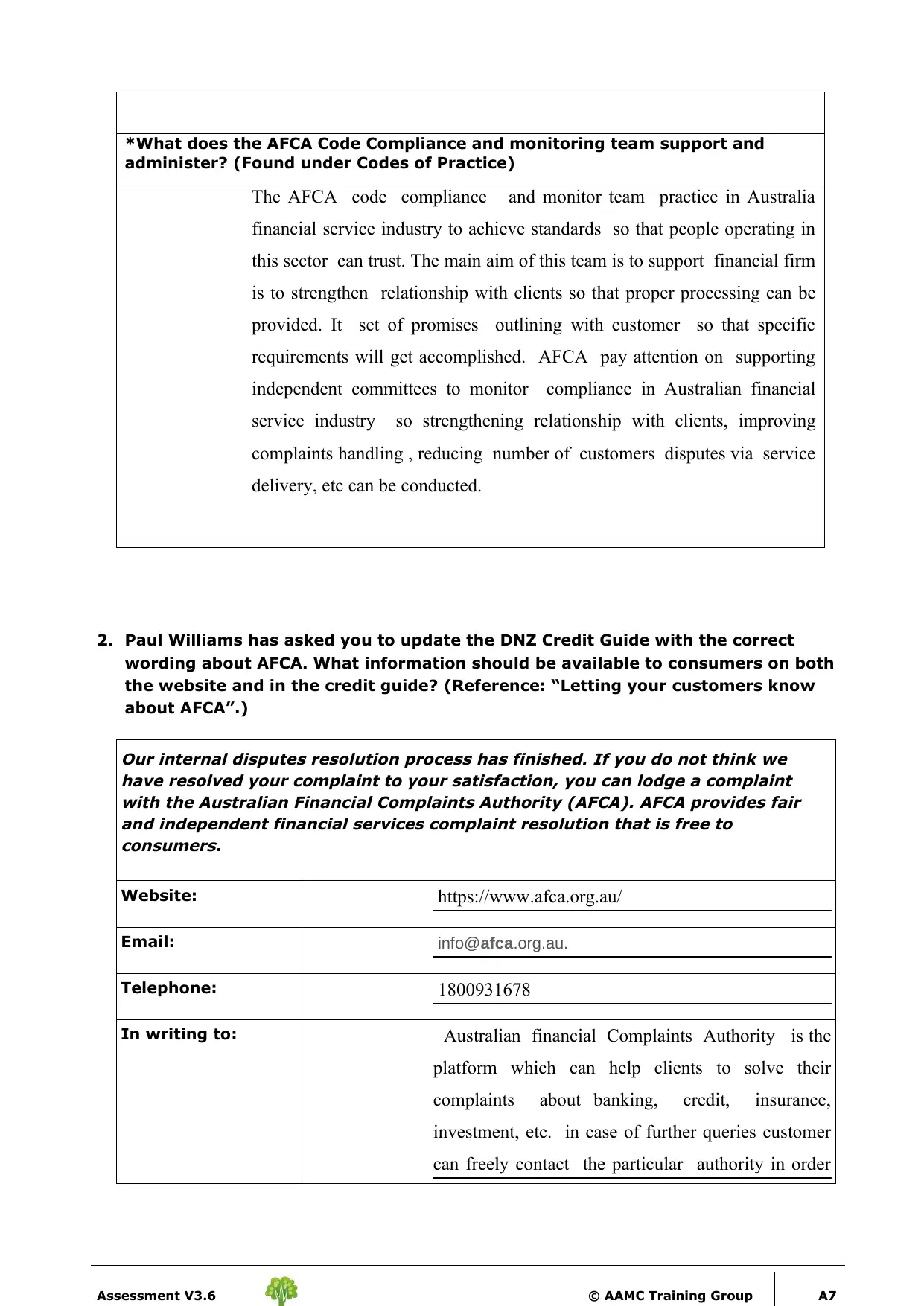
*What does the AFCA Code Compliance and monitoring team support and
administer? (Found under Codes of Practice)
The AFCA code compliance and monitor team practice in Australia
financial service industry to achieve standards so that people operating in
this sector can trust. The main aim of this team is to support financial firm
is to strengthen relationship with clients so that proper processing can be
provided. It set of promises outlining with customer so that specific
requirements will get accomplished. AFCA pay attention on supporting
independent committees to monitor compliance in Australian financial
service industry so strengthening relationship with clients, improving
complaints handling , reducing number of customers disputes via service
delivery, etc can be conducted.
2. Paul Williams has asked you to update the DNZ Credit Guide with the correct
wording about AFCA. What information should be available to consumers on both
the website and in the credit guide? (Reference: “Letting your customers know
about AFCA”.)
Our internal disputes resolution process has finished. If you do not think we
have resolved your complaint to your satisfaction, you can lodge a complaint
with the Australian Financial Complaints Authority (AFCA). AFCA provides fair
and independent financial services complaint resolution that is free to
consumers.
Website: https://www.afca.org.au/
Email: info@afca.org.au.
Telephone: 1800931678
In writing to: Australian financial Complaints Authority is the
platform which can help clients to solve their
complaints about banking, credit, insurance,
investment, etc. in case of further queries customer
can freely contact the particular authority in order
Assessment V3.6 © AAMC Training Group A7
administer? (Found under Codes of Practice)
The AFCA code compliance and monitor team practice in Australia
financial service industry to achieve standards so that people operating in
this sector can trust. The main aim of this team is to support financial firm
is to strengthen relationship with clients so that proper processing can be
provided. It set of promises outlining with customer so that specific
requirements will get accomplished. AFCA pay attention on supporting
independent committees to monitor compliance in Australian financial
service industry so strengthening relationship with clients, improving
complaints handling , reducing number of customers disputes via service
delivery, etc can be conducted.
2. Paul Williams has asked you to update the DNZ Credit Guide with the correct
wording about AFCA. What information should be available to consumers on both
the website and in the credit guide? (Reference: “Letting your customers know
about AFCA”.)
Our internal disputes resolution process has finished. If you do not think we
have resolved your complaint to your satisfaction, you can lodge a complaint
with the Australian Financial Complaints Authority (AFCA). AFCA provides fair
and independent financial services complaint resolution that is free to
consumers.
Website: https://www.afca.org.au/
Email: info@afca.org.au.
Telephone: 1800931678
In writing to: Australian financial Complaints Authority is the
platform which can help clients to solve their
complaints about banking, credit, insurance,
investment, etc. in case of further queries customer
can freely contact the particular authority in order
Assessment V3.6 © AAMC Training Group A7
Paraphrase This Document
Need a fresh take? Get an instant paraphrase of this document with our AI Paraphraser
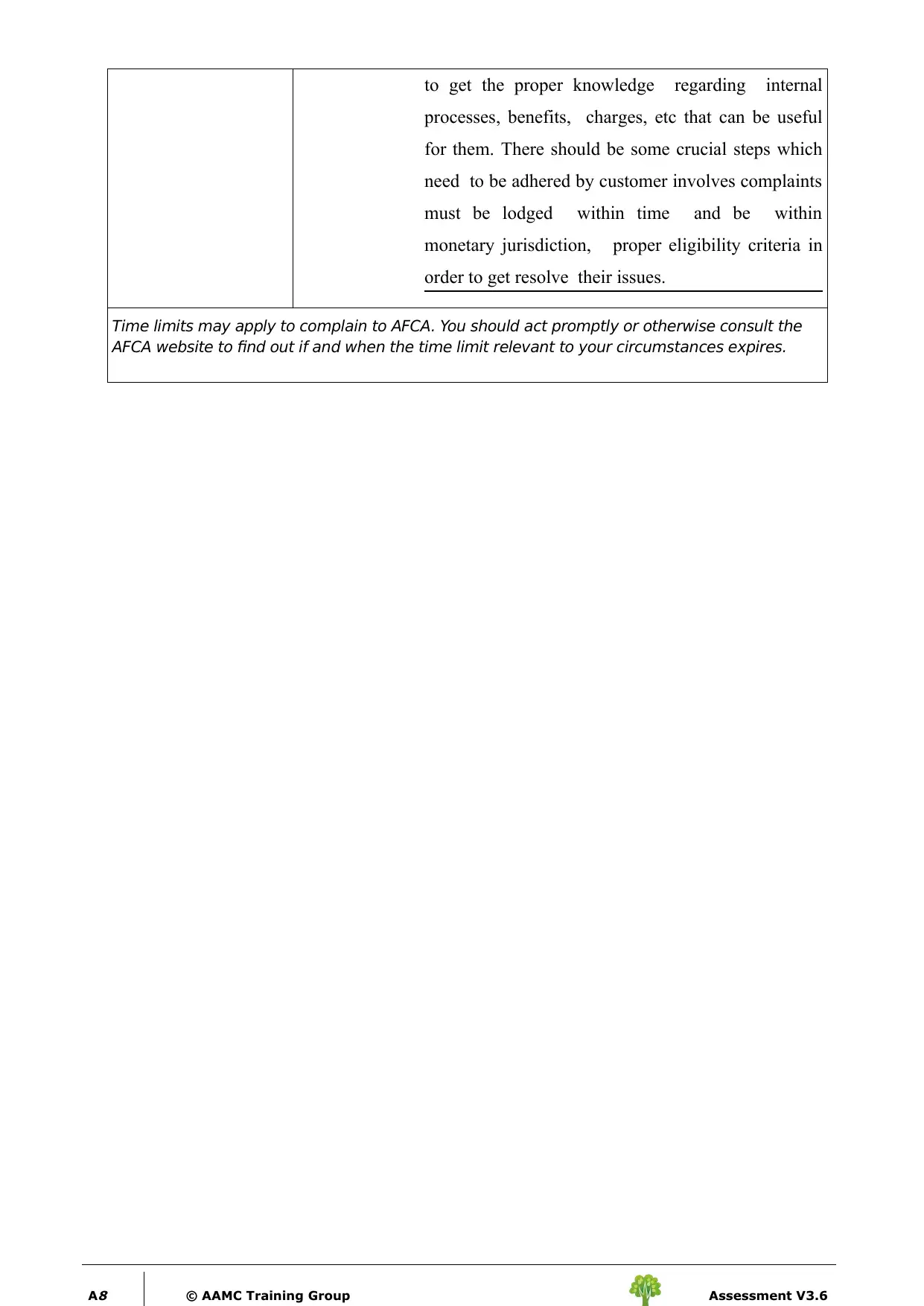
to get the proper knowledge regarding internal
processes, benefits, charges, etc that can be useful
for them. There should be some crucial steps which
need to be adhered by customer involves complaints
must be lodged within time and be within
monetary jurisdiction, proper eligibility criteria in
order to get resolve their issues.
Time limits may apply to complain to AFCA. You should act promptly or otherwise consult the
AFCA website to find out if and when the time limit relevant to your circumstances expires.
A
8 © AAMC Training Group Assessment V3.6
processes, benefits, charges, etc that can be useful
for them. There should be some crucial steps which
need to be adhered by customer involves complaints
must be lodged within time and be within
monetary jurisdiction, proper eligibility criteria in
order to get resolve their issues.
Time limits may apply to complain to AFCA. You should act promptly or otherwise consult the
AFCA website to find out if and when the time limit relevant to your circumstances expires.
A
8 © AAMC Training Group Assessment V3.6
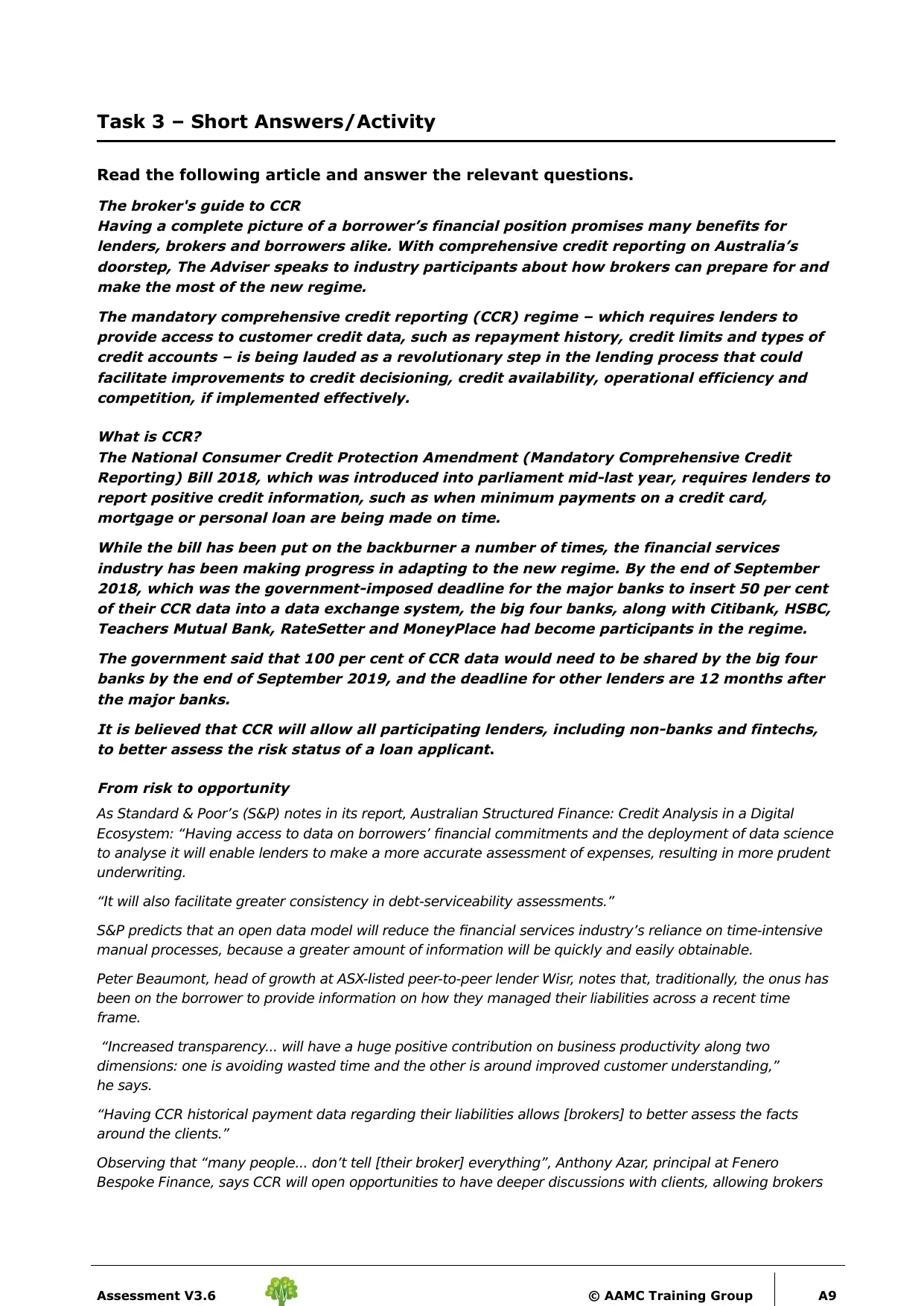
Task 3 – Short Answers/Activity
Read the following article and answer the relevant questions.The broker's guide to CCR
Having a complete picture of a borrower’s financial position promises many benefits for
lenders, brokers and borrowers alike. With comprehensive credit reporting on Australia’s
doorstep, The Adviser speaks to industry participants about how brokers can prepare for and
make the most of the new regime.
The mandatory comprehensive credit reporting (CCR) regime – which requires lenders to
provide access to customer credit data, such as repayment history, credit limits and types of
credit accounts – is being lauded as a revolutionary step in the lending process that could
facilitate improvements to credit decisioning, credit availability, operational efficiency and
competition, if implemented effectively.
What is CCR?
The National Consumer Credit Protection Amendment (Mandatory Comprehensive Credit
Reporting) Bill 2018, which was introduced into parliament mid-last year, requires lenders to
report positive credit information, such as when minimum payments on a credit card,
mortgage or personal loan are being made on time.
While the bill has been put on the backburner a number of times, the financial services
industry has been making progress in adapting to the new regime. By the end of September
2018, which was the government-imposed deadline for the major banks to insert 50 per cent
of their CCR data into a data exchange system, the big four banks, along with Citibank, HSBC,
Teachers Mutual Bank, RateSetter and MoneyPlace had become participants in the regime.
The government said that 100 per cent of CCR data would need to be shared by the big four
banks by the end of September 2019, and the deadline for other lenders are 12 months after
the major banks.
It is believed that CCR will allow all participating lenders, including non-banks and fintechs,
to better assess the risk status of a loan applicant.
From risk to opportunity
As Standard & Poor’s (S&P) notes in its report, Australian Structured Finance: Credit Analysis in a Digital
Ecosystem: “Having access to data on borrowers’ financial commitments and the deployment of data science
to analyse it will enable lenders to make a more accurate assessment of expenses, resulting in more prudent
underwriting.
“It will also facilitate greater consistency in debt-serviceability assessments.”
S&P predicts that an open data model will reduce the financial services industry’s reliance on time-intensive
manual processes, because a greater amount of information will be quickly and easily obtainable.
Peter Beaumont, head of growth at ASX-listed peer-to-peer lender Wisr, notes that, traditionally, the onus has
been on the borrower to provide information on how they managed their liabilities across a recent time
frame.
“Increased transparency... will have a huge positive contribution on business productivity along two
dimensions: one is avoiding wasted time and the other is around improved customer understanding,”
he says.
“Having CCR historical payment data regarding their liabilities allows [brokers] to better assess the facts
around the clients.”
Observing that “many people... don’t tell [their broker] everything”, Anthony Azar, principal at Fenero
Bespoke Finance, says CCR will open opportunities to have deeper discussions with clients, allowing brokers
Assessment V3.6 © AAMC Training Group A9
Read the following article and answer the relevant questions.The broker's guide to CCR
Having a complete picture of a borrower’s financial position promises many benefits for
lenders, brokers and borrowers alike. With comprehensive credit reporting on Australia’s
doorstep, The Adviser speaks to industry participants about how brokers can prepare for and
make the most of the new regime.
The mandatory comprehensive credit reporting (CCR) regime – which requires lenders to
provide access to customer credit data, such as repayment history, credit limits and types of
credit accounts – is being lauded as a revolutionary step in the lending process that could
facilitate improvements to credit decisioning, credit availability, operational efficiency and
competition, if implemented effectively.
What is CCR?
The National Consumer Credit Protection Amendment (Mandatory Comprehensive Credit
Reporting) Bill 2018, which was introduced into parliament mid-last year, requires lenders to
report positive credit information, such as when minimum payments on a credit card,
mortgage or personal loan are being made on time.
While the bill has been put on the backburner a number of times, the financial services
industry has been making progress in adapting to the new regime. By the end of September
2018, which was the government-imposed deadline for the major banks to insert 50 per cent
of their CCR data into a data exchange system, the big four banks, along with Citibank, HSBC,
Teachers Mutual Bank, RateSetter and MoneyPlace had become participants in the regime.
The government said that 100 per cent of CCR data would need to be shared by the big four
banks by the end of September 2019, and the deadline for other lenders are 12 months after
the major banks.
It is believed that CCR will allow all participating lenders, including non-banks and fintechs,
to better assess the risk status of a loan applicant.
From risk to opportunity
As Standard & Poor’s (S&P) notes in its report, Australian Structured Finance: Credit Analysis in a Digital
Ecosystem: “Having access to data on borrowers’ financial commitments and the deployment of data science
to analyse it will enable lenders to make a more accurate assessment of expenses, resulting in more prudent
underwriting.
“It will also facilitate greater consistency in debt-serviceability assessments.”
S&P predicts that an open data model will reduce the financial services industry’s reliance on time-intensive
manual processes, because a greater amount of information will be quickly and easily obtainable.
Peter Beaumont, head of growth at ASX-listed peer-to-peer lender Wisr, notes that, traditionally, the onus has
been on the borrower to provide information on how they managed their liabilities across a recent time
frame.
“Increased transparency... will have a huge positive contribution on business productivity along two
dimensions: one is avoiding wasted time and the other is around improved customer understanding,”
he says.
“Having CCR historical payment data regarding their liabilities allows [brokers] to better assess the facts
around the clients.”
Observing that “many people... don’t tell [their broker] everything”, Anthony Azar, principal at Fenero
Bespoke Finance, says CCR will open opportunities to have deeper discussions with clients, allowing brokers
Assessment V3.6 © AAMC Training Group A9
⊘ This is a preview!⊘
Do you want full access?
Subscribe today to unlock all pages.

Trusted by 1+ million students worldwide
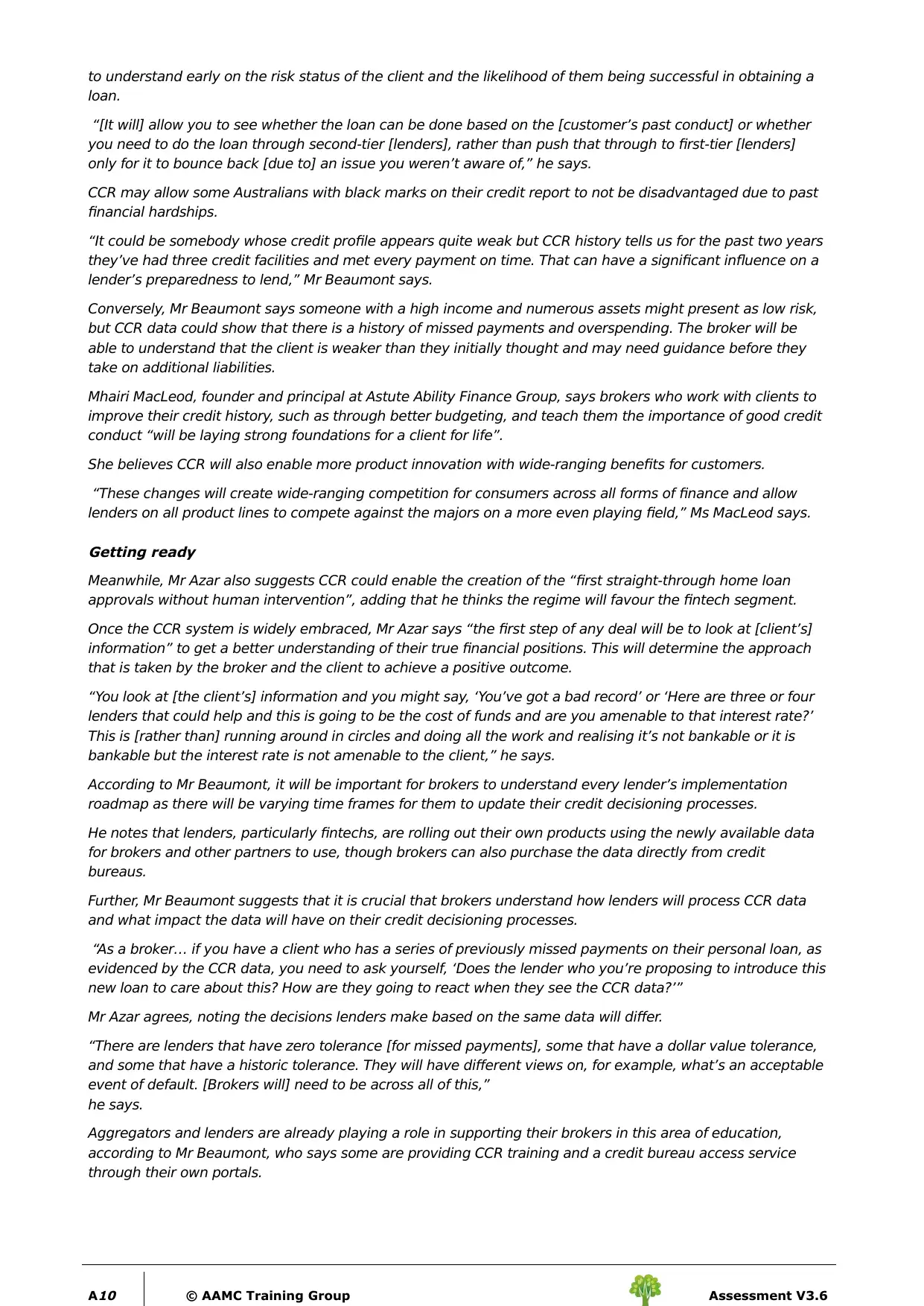
to understand early on the risk status of the client and the likelihood of them being successful in obtaining a
loan.
“[It will] allow you to see whether the loan can be done based on the [customer’s past conduct] or whether
you need to do the loan through second-tier [lenders], rather than push that through to first-tier [lenders]
only for it to bounce back [due to] an issue you weren’t aware of,” he says.
CCR may allow some Australians with black marks on their credit report to not be disadvantaged due to past
financial hardships.
“It could be somebody whose credit profile appears quite weak but CCR history tells us for the past two years
they’ve had three credit facilities and met every payment on time. That can have a significant influence on a
lender’s preparedness to lend,” Mr Beaumont says.
Conversely, Mr Beaumont says someone with a high income and numerous assets might present as low risk,
but CCR data could show that there is a history of missed payments and overspending. The broker will be
able to understand that the client is weaker than they initially thought and may need guidance before they
take on additional liabilities.
Mhairi MacLeod, founder and principal at Astute Ability Finance Group, says brokers who work with clients to
improve their credit history, such as through better budgeting, and teach them the importance of good credit
conduct “will be laying strong foundations for a client for life”.
She believes CCR will also enable more product innovation with wide-ranging benefits for customers.
“These changes will create wide-ranging competition for consumers across all forms of finance and allow
lenders on all product lines to compete against the majors on a more even playing field,” Ms MacLeod says.
Getting ready
Meanwhile, Mr Azar also suggests CCR could enable the creation of the “first straight-through home loan
approvals without human intervention”, adding that he thinks the regime will favour the fintech segment.
Once the CCR system is widely embraced, Mr Azar says “the first step of any deal will be to look at [client’s]
information” to get a better understanding of their true financial positions. This will determine the approach
that is taken by the broker and the client to achieve a positive outcome.
“You look at [the client’s] information and you might say, ‘You’ve got a bad record’ or ‘Here are three or four
lenders that could help and this is going to be the cost of funds and are you amenable to that interest rate?’
This is [rather than] running around in circles and doing all the work and realising it’s not bankable or it is
bankable but the interest rate is not amenable to the client,” he says.
According to Mr Beaumont, it will be important for brokers to understand every lender’s implementation
roadmap as there will be varying time frames for them to update their credit decisioning processes.
He notes that lenders, particularly fintechs, are rolling out their own products using the newly available data
for brokers and other partners to use, though brokers can also purchase the data directly from credit
bureaus.
Further, Mr Beaumont suggests that it is crucial that brokers understand how lenders will process CCR data
and what impact the data will have on their credit decisioning processes.
“As a broker… if you have a client who has a series of previously missed payments on their personal loan, as
evidenced by the CCR data, you need to ask yourself, ‘Does the lender who you’re proposing to introduce this
new loan to care about this? How are they going to react when they see the CCR data?’”
Mr Azar agrees, noting the decisions lenders make based on the same data will differ.
“There are lenders that have zero tolerance [for missed payments], some that have a dollar value tolerance,
and some that have a historic tolerance. They will have different views on, for example, what’s an acceptable
event of default. [Brokers will] need to be across all of this,”
he says.
Aggregators and lenders are already playing a role in supporting their brokers in this area of education,
according to Mr Beaumont, who says some are providing CCR training and a credit bureau access service
through their own portals.
A
10 © AAMC Training Group Assessment V3.6
loan.
“[It will] allow you to see whether the loan can be done based on the [customer’s past conduct] or whether
you need to do the loan through second-tier [lenders], rather than push that through to first-tier [lenders]
only for it to bounce back [due to] an issue you weren’t aware of,” he says.
CCR may allow some Australians with black marks on their credit report to not be disadvantaged due to past
financial hardships.
“It could be somebody whose credit profile appears quite weak but CCR history tells us for the past two years
they’ve had three credit facilities and met every payment on time. That can have a significant influence on a
lender’s preparedness to lend,” Mr Beaumont says.
Conversely, Mr Beaumont says someone with a high income and numerous assets might present as low risk,
but CCR data could show that there is a history of missed payments and overspending. The broker will be
able to understand that the client is weaker than they initially thought and may need guidance before they
take on additional liabilities.
Mhairi MacLeod, founder and principal at Astute Ability Finance Group, says brokers who work with clients to
improve their credit history, such as through better budgeting, and teach them the importance of good credit
conduct “will be laying strong foundations for a client for life”.
She believes CCR will also enable more product innovation with wide-ranging benefits for customers.
“These changes will create wide-ranging competition for consumers across all forms of finance and allow
lenders on all product lines to compete against the majors on a more even playing field,” Ms MacLeod says.
Getting ready
Meanwhile, Mr Azar also suggests CCR could enable the creation of the “first straight-through home loan
approvals without human intervention”, adding that he thinks the regime will favour the fintech segment.
Once the CCR system is widely embraced, Mr Azar says “the first step of any deal will be to look at [client’s]
information” to get a better understanding of their true financial positions. This will determine the approach
that is taken by the broker and the client to achieve a positive outcome.
“You look at [the client’s] information and you might say, ‘You’ve got a bad record’ or ‘Here are three or four
lenders that could help and this is going to be the cost of funds and are you amenable to that interest rate?’
This is [rather than] running around in circles and doing all the work and realising it’s not bankable or it is
bankable but the interest rate is not amenable to the client,” he says.
According to Mr Beaumont, it will be important for brokers to understand every lender’s implementation
roadmap as there will be varying time frames for them to update their credit decisioning processes.
He notes that lenders, particularly fintechs, are rolling out their own products using the newly available data
for brokers and other partners to use, though brokers can also purchase the data directly from credit
bureaus.
Further, Mr Beaumont suggests that it is crucial that brokers understand how lenders will process CCR data
and what impact the data will have on their credit decisioning processes.
“As a broker… if you have a client who has a series of previously missed payments on their personal loan, as
evidenced by the CCR data, you need to ask yourself, ‘Does the lender who you’re proposing to introduce this
new loan to care about this? How are they going to react when they see the CCR data?’”
Mr Azar agrees, noting the decisions lenders make based on the same data will differ.
“There are lenders that have zero tolerance [for missed payments], some that have a dollar value tolerance,
and some that have a historic tolerance. They will have different views on, for example, what’s an acceptable
event of default. [Brokers will] need to be across all of this,”
he says.
Aggregators and lenders are already playing a role in supporting their brokers in this area of education,
according to Mr Beaumont, who says some are providing CCR training and a credit bureau access service
through their own portals.
A
10 © AAMC Training Group Assessment V3.6
Paraphrase This Document
Need a fresh take? Get an instant paraphrase of this document with our AI Paraphraser
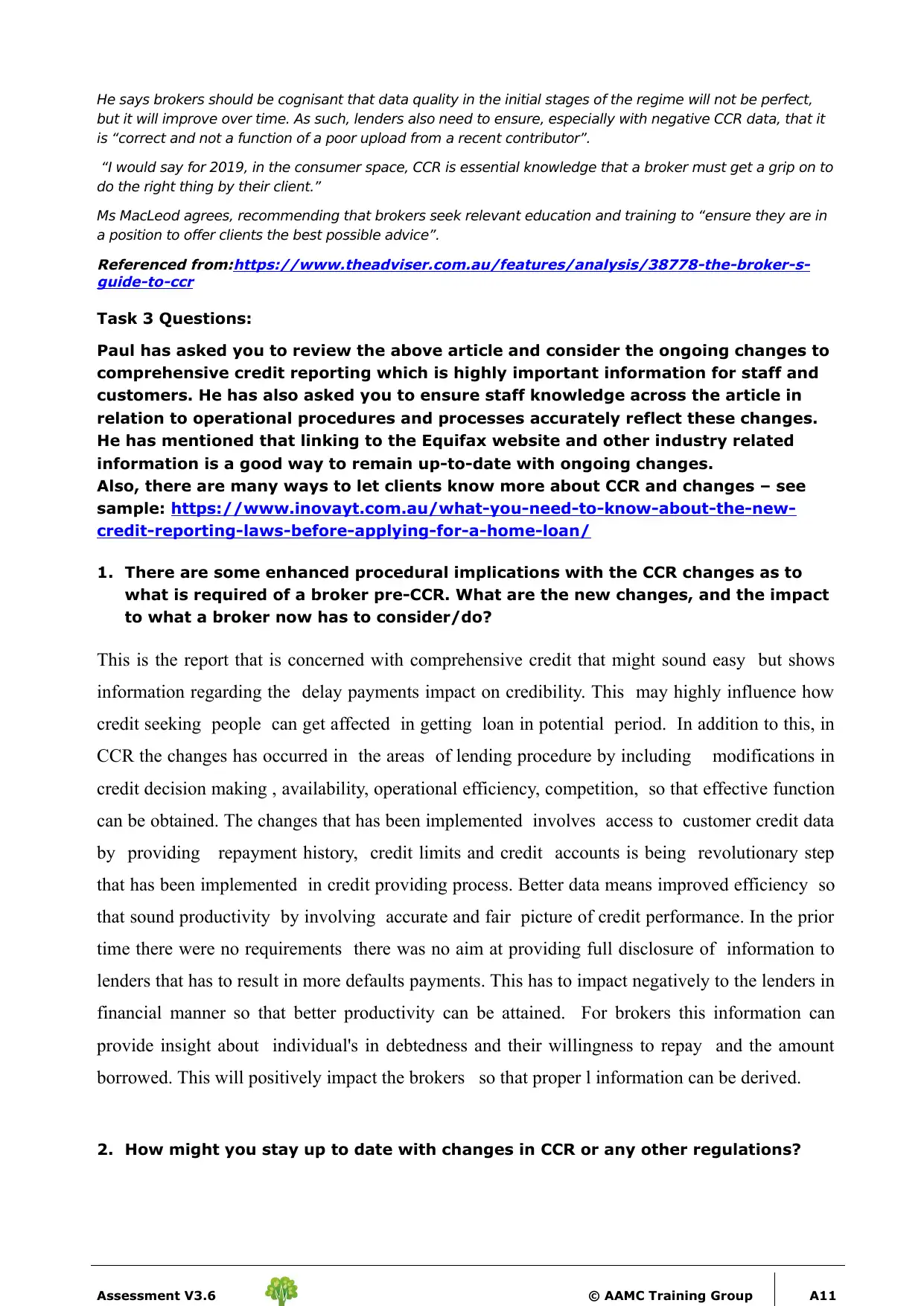
He says brokers should be cognisant that data quality in the initial stages of the regime will not be perfect,
but it will improve over time. As such, lenders also need to ensure, especially with negative CCR data, that it
is “correct and not a function of a poor upload from a recent contributor”.
“I would say for 2019, in the consumer space, CCR is essential knowledge that a broker must get a grip on to
do the right thing by their client.”
Ms MacLeod agrees, recommending that brokers seek relevant education and training to “ensure they are in
a position to offer clients the best possible advice”.Referenced from:https://www.theadviser.com.au/features/analysis/38778-the-broker-s-
guide-to-ccr
Task 3 Questions:
Paul has asked you to review the above article and consider the ongoing changes to
comprehensive credit reporting which is highly important information for staff and
customers. He has also asked you to ensure staff knowledge across the article in
relation to operational procedures and processes accurately reflect these changes.
He has mentioned that linking to the Equifax website and other industry related
information is a good way to remain up-to-date with ongoing changes.
Also, there are many ways to let clients know more about CCR and changes – see
sample: https://www.inovayt.com.au/what-you-need-to-know-about-the-new-
credit-reporting-laws-before-applying-for-a-home-loan/
1. There are some enhanced procedural implications with the CCR changes as to
what is required of a broker pre-CCR. What are the new changes, and the impact
to what a broker now has to consider/do?
This is the report that is concerned with comprehensive credit that might sound easy but shows
information regarding the delay payments impact on credibility. This may highly influence how
credit seeking people can get affected in getting loan in potential period. In addition to this, in
CCR the changes has occurred in the areas of lending procedure by including modifications in
credit decision making , availability, operational efficiency, competition, so that effective function
can be obtained. The changes that has been implemented involves access to customer credit data
by providing repayment history, credit limits and credit accounts is being revolutionary step
that has been implemented in credit providing process. Better data means improved efficiency so
that sound productivity by involving accurate and fair picture of credit performance. In the prior
time there were no requirements there was no aim at providing full disclosure of information to
lenders that has to result in more defaults payments. This has to impact negatively to the lenders in
financial manner so that better productivity can be attained. For brokers this information can
provide insight about individual's in debtedness and their willingness to repay and the amount
borrowed. This will positively impact the brokers so that proper l information can be derived.
2. How might you stay up to date with changes in CCR or any other regulations?
Assessment V3.6 © AAMC Training Group A11
but it will improve over time. As such, lenders also need to ensure, especially with negative CCR data, that it
is “correct and not a function of a poor upload from a recent contributor”.
“I would say for 2019, in the consumer space, CCR is essential knowledge that a broker must get a grip on to
do the right thing by their client.”
Ms MacLeod agrees, recommending that brokers seek relevant education and training to “ensure they are in
a position to offer clients the best possible advice”.Referenced from:https://www.theadviser.com.au/features/analysis/38778-the-broker-s-
guide-to-ccr
Task 3 Questions:
Paul has asked you to review the above article and consider the ongoing changes to
comprehensive credit reporting which is highly important information for staff and
customers. He has also asked you to ensure staff knowledge across the article in
relation to operational procedures and processes accurately reflect these changes.
He has mentioned that linking to the Equifax website and other industry related
information is a good way to remain up-to-date with ongoing changes.
Also, there are many ways to let clients know more about CCR and changes – see
sample: https://www.inovayt.com.au/what-you-need-to-know-about-the-new-
credit-reporting-laws-before-applying-for-a-home-loan/
1. There are some enhanced procedural implications with the CCR changes as to
what is required of a broker pre-CCR. What are the new changes, and the impact
to what a broker now has to consider/do?
This is the report that is concerned with comprehensive credit that might sound easy but shows
information regarding the delay payments impact on credibility. This may highly influence how
credit seeking people can get affected in getting loan in potential period. In addition to this, in
CCR the changes has occurred in the areas of lending procedure by including modifications in
credit decision making , availability, operational efficiency, competition, so that effective function
can be obtained. The changes that has been implemented involves access to customer credit data
by providing repayment history, credit limits and credit accounts is being revolutionary step
that has been implemented in credit providing process. Better data means improved efficiency so
that sound productivity by involving accurate and fair picture of credit performance. In the prior
time there were no requirements there was no aim at providing full disclosure of information to
lenders that has to result in more defaults payments. This has to impact negatively to the lenders in
financial manner so that better productivity can be attained. For brokers this information can
provide insight about individual's in debtedness and their willingness to repay and the amount
borrowed. This will positively impact the brokers so that proper l information can be derived.
2. How might you stay up to date with changes in CCR or any other regulations?
Assessment V3.6 © AAMC Training Group A11
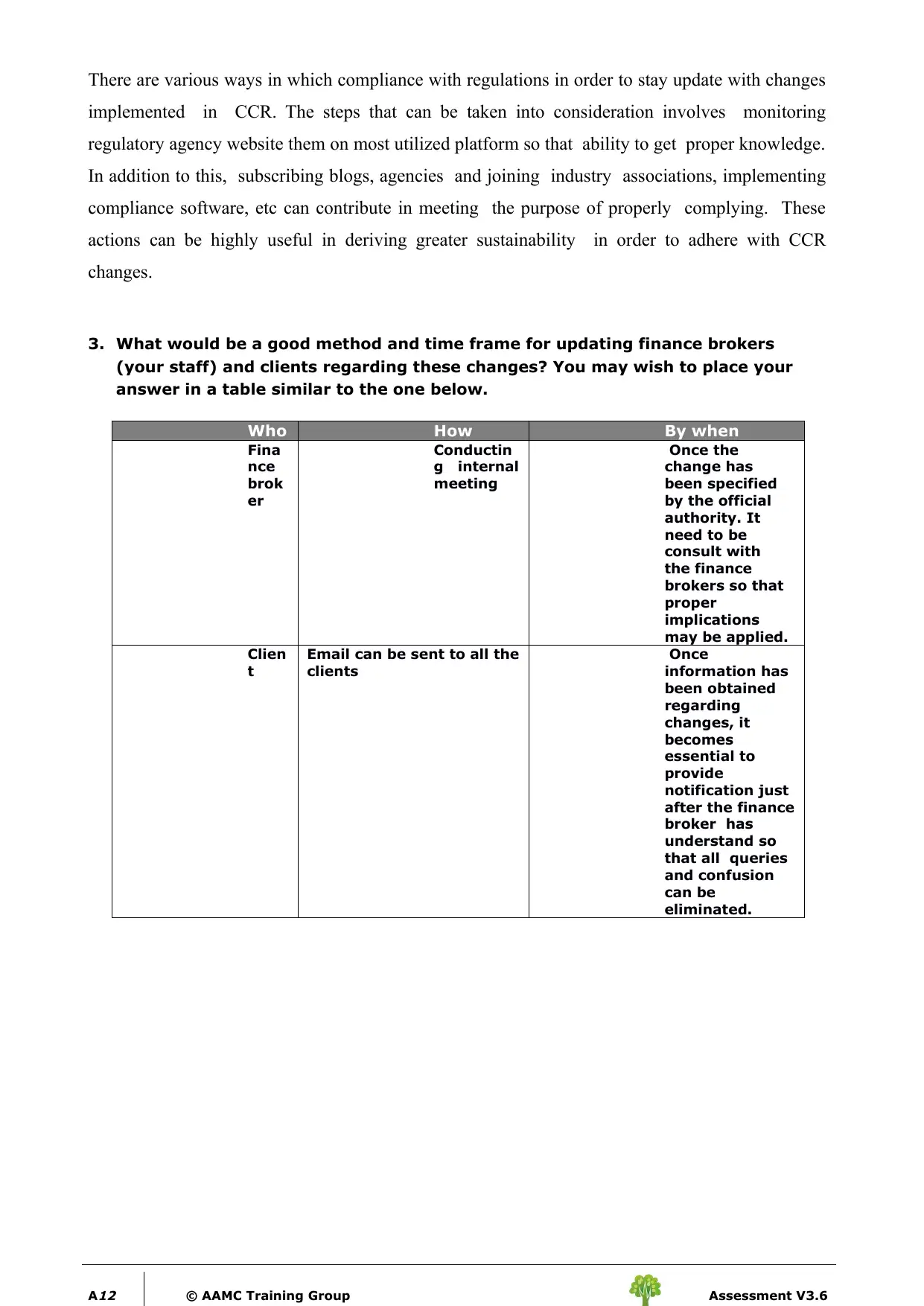
There are various ways in which compliance with regulations in order to stay update with changes
implemented in CCR. The steps that can be taken into consideration involves monitoring
regulatory agency website them on most utilized platform so that ability to get proper knowledge.
In addition to this, subscribing blogs, agencies and joining industry associations, implementing
compliance software, etc can contribute in meeting the purpose of properly complying. These
actions can be highly useful in deriving greater sustainability in order to adhere with CCR
changes.
3. What would be a good method and time frame for updating finance brokers
(your staff) and clients regarding these changes? You may wish to place your
answer in a table similar to the one below.
Who How By when
Fina
nce
brok
er
Conductin
g internal
meeting
Once the
change has
been specified
by the official
authority. It
need to be
consult with
the finance
brokers so that
proper
implications
may be applied.
Clien
t
Email can be sent to all the
clients
Once
information has
been obtained
regarding
changes, it
becomes
essential to
provide
notification just
after the finance
broker has
understand so
that all queries
and confusion
can be
eliminated.
A
12 © AAMC Training Group Assessment V3.6
implemented in CCR. The steps that can be taken into consideration involves monitoring
regulatory agency website them on most utilized platform so that ability to get proper knowledge.
In addition to this, subscribing blogs, agencies and joining industry associations, implementing
compliance software, etc can contribute in meeting the purpose of properly complying. These
actions can be highly useful in deriving greater sustainability in order to adhere with CCR
changes.
3. What would be a good method and time frame for updating finance brokers
(your staff) and clients regarding these changes? You may wish to place your
answer in a table similar to the one below.
Who How By when
Fina
nce
brok
er
Conductin
g internal
meeting
Once the
change has
been specified
by the official
authority. It
need to be
consult with
the finance
brokers so that
proper
implications
may be applied.
Clien
t
Email can be sent to all the
clients
Once
information has
been obtained
regarding
changes, it
becomes
essential to
provide
notification just
after the finance
broker has
understand so
that all queries
and confusion
can be
eliminated.
A
12 © AAMC Training Group Assessment V3.6
⊘ This is a preview!⊘
Do you want full access?
Subscribe today to unlock all pages.

Trusted by 1+ million students worldwide
1 out of 27
Related Documents
Your All-in-One AI-Powered Toolkit for Academic Success.
+13062052269
info@desklib.com
Available 24*7 on WhatsApp / Email
![[object Object]](/_next/static/media/star-bottom.7253800d.svg)
Unlock your academic potential
Copyright © 2020–2025 A2Z Services. All Rights Reserved. Developed and managed by ZUCOL.




